Understanding Cupcake Liner Sizes: A Comprehensive Guide
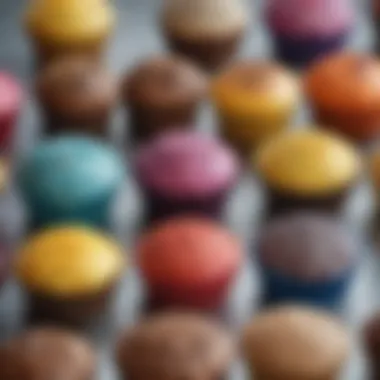
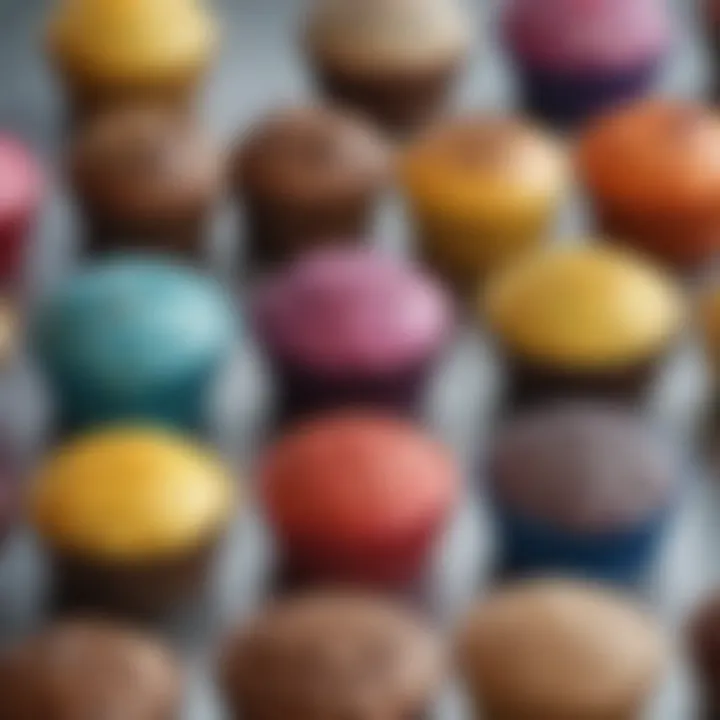
Intro
Cupcake liners are often viewed as a simple accessory in baking, but their significance extends far beyond aesthetics. Understanding the various sizes and types of cupcake liners is essential for achieving optimal baking results. This guide provides a comprehensive analysis of cupcake liner sizes, with a focus on their applications, variations, and their influence on baking outcomes.
Being well-informed about which liner to select can elevate not only the presentation but also the taste and texture of your cupcakes. Whether a novice or an experienced baker, this guide aims to equip you with the necessary knowledge to enhance your baking practice.
Preface to Cupcake Liners
Cupcake liners are an often-overlooked accessory in baking that serve both functional and aesthetic purposes. Their significance lies in their ability to simplify the baking process while enhancing the presentation of cupcakes. With a variety of materials, sizes, and designs available, cupcake liners have evolved to cater to diverse baking needs and preferences. In this section, we address the role of cupcake liners and why they are essential for bakers and dessert enthusiasts alike.
Definition and Purpose
Cupcake liners, also known as cupcake wrappers, are protective coverings placed inside muffin tins to hold cupcake batter. They provide separation between the batter and the metal or silicone directly while baking. The main purposes of these liners include:
- Ease of removal: Liners allow for easy extraction of the cupcakes from the baking tin without damaging their shape.
- Hygiene: They help prevent direct contact between batter and pan, promoting cleaner baking practices.
- Aesthetic appeal: Different colors and patterns enhance the visual presentation of baked goods, making them more appealing to consumers.
Furthermore, cupcake liners can also influence baking characteristics. The materials can affect moisture retention and baking time, which are crucial considerations for achieving a perfect cupcake.
Historical Context
The history of cupcake liners can be traced back to the origins of baking itself. Traditional cupcake baking did not utilize liners, relying instead on greasing the tins. However, as baking evolved and became more accessible to home cooks, the introduction of disposable paper liners marked a turning point. They were invented in the early 20th century, originally made from parchment paper. Over time, the designs and materials changed.
In the late 20th century, with the rise of the baking industry and home baking culture, manufacturers began producing a wider variety of decorative liners. These innovations allowed bakers to express creativity, making cupcakes not only delicious but also visually appealing. Today, cupcake liners are an integral part of baking, often utilized in professional settings as well as for casual baking at home.
Types of Cupcake Liners
Understanding the various types of cupcake liners is essential for anyone who enjoys baking. Each type offers unique benefits and applications. The choice of cupcake liner can affect the bake quality, presentation, and even the ease of serving. This section explores the different types of liners, their characteristics, and what bakers should consider when selecting them.
Standard Paper Liners
Standard paper liners are the most commonly used type in baking. They are available in a wide range of colors and patterns, making them not only functional but also decorative. These liners are typically made from parchment paper, which is treated to be non-stick, allowing cupcakes to be removed easily after baking.
When using standard paper liners, it is important to consider their thickness. Thicker liners may provide better moisture retention, while thinner ones can reduce baking time slightly. Additionally, they come in various sizes, ensuring a good fit for standard cupcake pans.
Greaseproof Liners
Greaseproof liners are specifically designed to resist moisture and grease from the batter. They are an excellent choice when baking recipes that are high in fat, such as those containing chocolate. These liners help maintain the integrity of both the cupcake and the appearance of the liner itself, as they do not become translucent when filled with batter.
Greaseproof liners are particularly useful when baking cupcakes with rich fillings or toppings that might otherwise color the liner.
Another advantage is that they often have a higher heat resistance, allowing for more even baking without the risk of burning. This characteristic is valuable for bakers looking to achieve a soft, moist texture in their cupcakes.
Reusable Silicone Liners
Silicone liners have gained popularity among environmentally conscious bakers. Unlike disposable liners, these can be washed and reused multiple times, reducing waste. They come in a variety of designs and colors, which appeal to those who value aesthetics in their baking tools.
Silicone liners possess excellent non-stick properties, leading to easy cupcake release. They are typically more flexible than paper liners, making it simple to pop out baked goods without risk of damage. However, they may hold heat differently, and bakers should adjust baking times accordingly to avoid overbaking or underbaking.
Foil Liners
Foil liners are another option worth considering. These metallic liners provide an eye-catching appearance and are highly effective in retaining heat. They are commonly used for specialty cupcakes and can add a touch of elegance to any presentation.
One benefit of foil liners is their ability to stand on their own, which means they do not require a muffin tin for support. This can be particularly advantageous for bakers who prefer a more rustic presentation. It is essential to note that foil liners may not be suitable for all types of batters, especially very light or airy ones, as they might not provide enough structure during baking.
In summary, choosing the right type of cupcake liner can significantly impact the overall baking experience and the final product. Each type offers distinct advantages depending on the specific baking needs and preferences.
Common Cupcake Liner Sizes
Understanding the various sizes of cupcake liners is crucial for bakers. Each size serves a unique purpose and can significantly influence the baking outcome. Selecting the appropriate liner size not only affects the presentation of cupcakes but also impacts baking times and even texture. Knowing the distinctions among mini, standard, and jumbo liners helps ensure bakers achieve their desired results, whether for a casual gathering or a formal event.
Mini Cupcake Liners
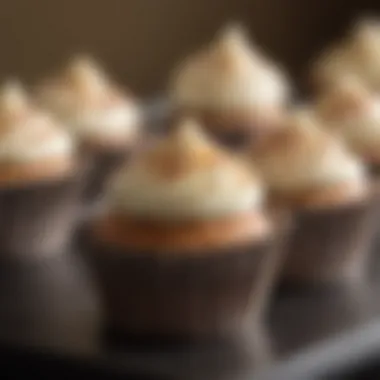
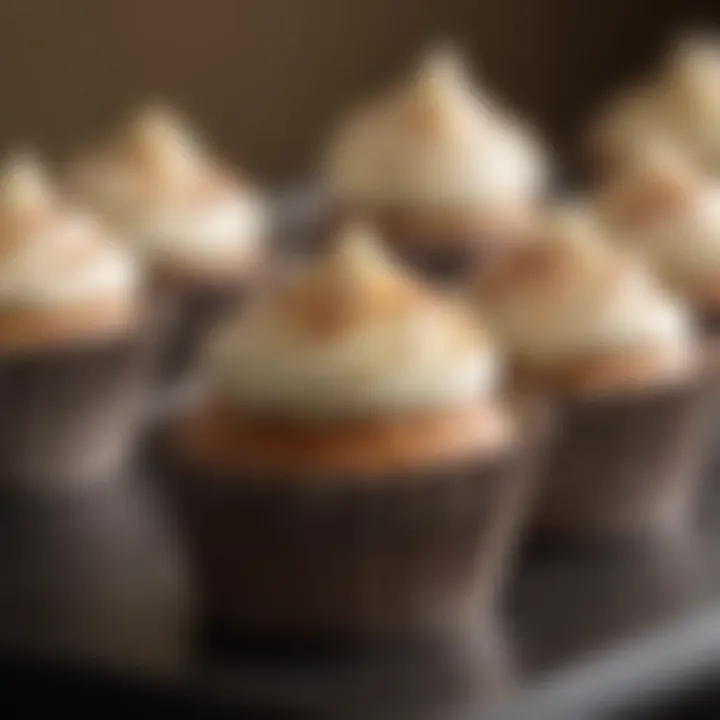
Mini cupcake liners are ideal for bite-sized treats. They typically measure about 1.5 inches in diameter at the base. These liners are particularly popular for mini versions of classic cupcakes or for serving as party favors. When using mini liners, it is essential to adjust batter volume accordingly to prevent overflows during baking. The small size allows for versatility in flavors, and they can be filled with various sweet fillings, making them appealing for children's events or gatherings needing appetizers.
Benefits of Mini Liners:
- Perfect for portion control
- Great for mixing and sharing different flavors
- Easier to decorate with small frosting techniques
The use of mini cupcake liners can encourage playful presentation. They look tidy and can add charm to any table setting.
Standard Cupcake Liners
Standard cupcake liners are the most commonly used size. Measuring around 2 inches in diameter at the top, they fit perfectly in standard cupcake pans. This size is versatile, suitable for a broad range of recipes from basic vanilla to more intricate flavors. Standard liners support a variety of fillings and frosts while providing sufficient space for various decorating techniques.
When baking with standard liners, it is essential to consider the batter's density. Thick batters may require slight adjustments in baking time, unlike thinner batters that may cook quicker.
Considerations for Standard Liners:
- Most versatile size for all occasions
- Fits most standard muffin trays
- Supports various baking techniques
These liners are available in a myriad of colors and designs, making them an attractive option for any baking project.
Jumbo Cupcake Liners
Jumbo cupcake liners measure approximately 3 inches in diameter, tailored for those who prefer larger cupcakes. These sizable liners allow bakers to be adventurous with flavors and toppings. While they offer more batter volume, careful monitoring of baking time is vital as jumbo cupcakes can take significantly longer to cook through than their mini or standard counterparts.
Baking in jumbo liners can also create visually striking presentations, making them a favorite for celebrations and special occasions. They can easily stand alone in a decorative cupcake holder or be part of an elaborate dessert display.
Key Advantages of Jumbo Liners:
- Ideal for unique flavor combinations
- Great for larger servings
- Allows for creative decoration possibilities
With these larger sizes, bakers can express creativity not only in flavor but also in presentation.
"Selecting the right cupcake liner size is not only about aesthetic appeal but also affects baking results directly. Choose wisely to enhance both looks and taste."
In summary, knowing about mini, standard, and jumbo cupcake liners allows for better decision-making when planning baking projects. Each size has its intrinsic value and caters to different baking styles and preferences. This understanding ultimately enhances a baker's ability to achieve their desired outcomes.
Choosing the Right Cupcake Liner Size
Selecting the correct cupcake liner size is essential for a successful baking experience. The right size not only ensures that the cupcakes maintain their shape, but also affects the final texture and taste. Breaching this aspect can lead to undesirable outcomes, such as overflows or undercooked centers. Hence, understanding the connection between liner size and the baking process is crucial for every baker.
Factors to Consider
When it comes to choosing cupcake liners, several factors play a significant role. These factors include:
- Purpose of your cupcakes: Are they for a birthday, wedding, or casual gathering? The occasion might influence your liner choice.
- Recipe specifications: Different recipes have specific requirements regarding batter volume and density. Make sure to consider this when selecting a liner size.
- Oven characteristics: Different ovens may have varying heat distributions, impacting how well cupcakes bake in different liner sizes.
These elements collectively guide you to make an informed decision on which cupcake liner will yield the best results.
Batter Volume and Density
Batter volume and density are crucial factors when choosing a liner size. A recipe with dense batter, like a chocolate cake, requires different consideration than a light and fluffy batter. If you use a larger liner with a heavy batter, it may require longer baking times. Conversely, a smaller liner may lead to overfilling, causing a messy overflow.
- For light batters, like vanilla sponge, a standard liner often suffices. They bake evenly and maintain a good rise.
- In the case of dense batters, opting for a larger liner could provide the necessary space for proper heat flow. This avoids the risk of underbaking.
Ultimately, understanding your batter type will aid in selecting a liner size that complements it well, ensuring an optimal baking outcome.
Impact of Cupcake Liner Size on Baking
The size of cupcake liners plays a crucial role in the baking process. It influences various factors that can affect the final outcome of your cupcakes. Different liner sizes determine how heat is distributed around the batter during baking, leading to potential differences in baking time, texture, and moisture retention. Understanding these aspects can significantly improve both the appearance and taste of your baked goods.
Baking Time Adjustments
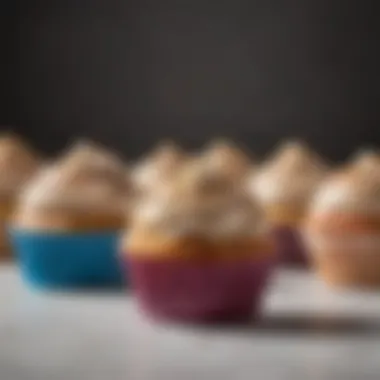
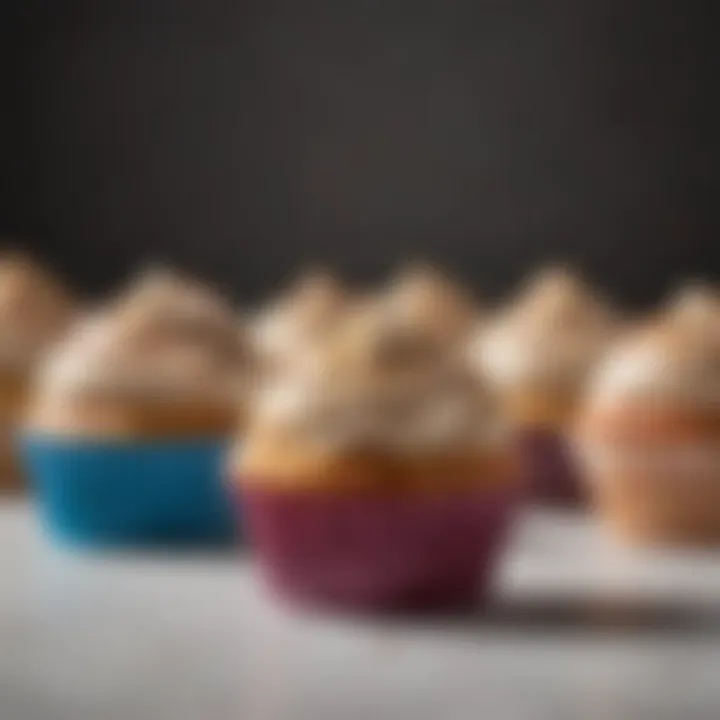
When using different sizes of cupcake liners, one must account for potential adjustments in baking time. Smaller liners, such as mini liners, generally lead to reduced baking time because the batter is spread thinner. Conversely, larger liners, like jumbo ones, may require a longer time to ensure thorough baking. For example:
- Mini Cupcake Liners: Typically, these will require about 10-15 minutes in the oven.
- Standard Cupcake Liners: Standard size generally takes around 15-20 minutes.
- Jumbo Cupcake Liners: Expect these to bake for 20-25 minutes or even longer.
It is vital to check for doneness using a toothpick test. Insert it into the center of a cupcake; if it comes out clean, then your batch is ready. Adjusting the baking time according to the liner size ensures that your cupcakes don't turn out undercooked or overbaked.
Texture and Moisture Retention
The texture and moisture of cupcakes can also be influenced by the type and size of the liner used. Paper liners tend to absorb some moisture from the batter, which can affect the final product's moistness. It is essential to consider the material of the liners along with their size. Here are some points to consider:
- Standard Paper Liners: These can create a slightly drier texture due to moisture absorption. However, they are suitable for most recipes.
- Greaseproof Liners: They retain moisture better than regular paper. This helps maintain a soft and moist cupcake.
- Silicone Liners: These can hold more moisture and produce a softer cupcake, often resulting in a more even bake.
Using the right size and material can enhance the overall texture. A well-baked cupcake should have a light, airy structure inside while still being moist. The interplay of liner size and baking variables is a fundamental aspect of effective cupcake baking, making it all the more important for both novice and experienced bakers to grasp these concepts.
Key Takeaway: The correct liner size affects not just the baking time but also the texture. Understanding this interplay can lead to better baking outcomes.
Cupcake Liner Materials and Their Influence
Choosing the right material for cupcake liners is crucial as it directly affects both the baking process and the final outcome. Different materials offer unique benefits and drawbacks that might influence your decision based on the intended use, preference for ease of use, and desired presentation. Understanding these materials can help bakers make informed decisions tailored to their specific needs.
Paper Liners: Pros and Cons
Paper liners are among the most commonly used cupcake liners. They are typically affordable and readily available in various colors and designs. Here are some advantages and disadvantages of using paper liners:
Pros:
- Affordability: They are usually cheaper compared to other materials.
- Wide variety: You can find them in numerous colors and patterns, making them suitable for themed events.
- Ease of use: They fit well in cupcake pans and do not require any extra preparation before use.
Cons:
- Moisture retention: Depending on the quality, some paper liners can absorb moisture while baking, affecting the texture of the cupcake.
- Non-reusability: Most paper liners are single-use only, which can be less environmentally friendly.
- Adherence issues: Sometimes, cupcakes may stick to the liner, making removal challenging.
Bakers must consider these aspects when selecting paper liners, particularly the quality and type to ensure they meet baking needs.
Silicone Liners: Benefits and Drawbacks
Silicone liners have gained popularity due to their unique properties and functionality. They stand out from traditional liners for various reasons:
Benefits:
- Reusable: One of the most significant advantages is their reusability, which makes them more eco-friendly compared to single-use options.
- Non-stick properties: Silicone does not stick to baked goods, allowing for easy removal of cupcakes without damage.
- Durability: They can withstand high temperatures and do not tear easily, providing a long-lasting alternative.
Drawbacks:
- Cost: Silicone liners are generally more expensive than paper counterparts, which may not suit every budget.
- Limited designs: While they come in various colors, silicone liners may lack the extensive decorative options provided by paper liners.
- Baking time consideration: Their heat conduction can differ from paper, potentially necessitating adjustments in baking time.
In summary, when selecting cupcake liners, bakers should weigh the advantages and disadvantages offered by different materials. Paper and silicone liners each have their own strengths and weaknesses, influencing the choice based on preferences and baking contexts.
"Selecting the right cupcake liner material can enhance not only the baking experience but also the final presentation of your cupcakes."
For more information on cupcake liners, check out resources like Wikipedia, and for discussions, visit Reddit.
Understanding the material influence is essential for anyone interested in perfecting their baking skills and achieving desirable results.
Decorative Cupcake Liners
Decorative cupcake liners play a significant role in baking, especially for those who prioritize presentation. They not only serve to hold the batter but also enhance the visual appeal of the final product. Bakeries and home bakers alike can benefit from incorporating decorative liners into their baking repertoire.
When choosing decorative liners, it is essential to consider the occasion and the desired aesthetic. Different events call for different themes, and cupcake liners can contribute significantly to the overall decor. They are available in various colors, patterns, and designs that can make cupcakes more appealing to the eye.
Additionally, decorative liners can reflect personal style and creativity. Selecting the right liner can transform a simple cupcake into a delightful treat that captures attention and evokes impresssion.
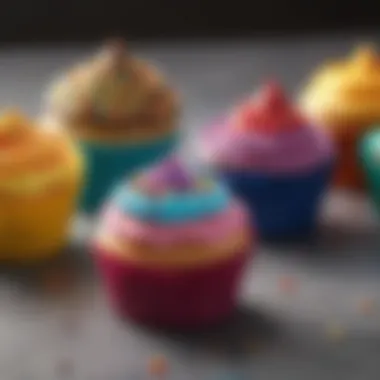
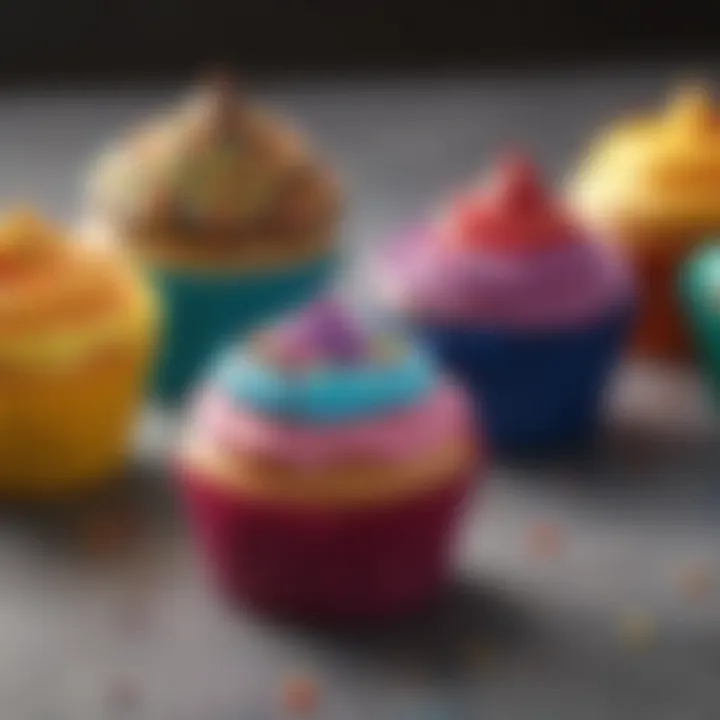
Types of Decorative Liners
Decorative cupcake liners come in several types, each offering unique features.
- Printed Paper Liners: These are often colorful and feature patterns or themed designs, perfect for festive occasions.
- Metallic Foil Liners: They provide a shiny, elegant look and often retain moisture well, preventing the cupcake from drying out.
- Textured Liners: Liners created with decorative textures can add depth to the cupcake's appearance.
- Liner Sets: Some brands offer sets that combine various designs, making it easier to match the cupcakes to any theme.
Usage Considerations
When using decorative cupcake liners, it is important to consider a few factors:
- Oven Safety: Ensure that the liners used are oven-safe to prevent burning or melting.
- Baking Properties: Some decorative liners may not be as effective in retaining moisture or cooking evenly. Testing on a small batch can help determine suitability.
- Compatibility: Make sure that the size of the liner matches the size of the cupcake or muffin tin. Liners that are too small or too large can lead to messes during baking.
Buying Guide for Cupcake Liners
Understanding how to buy cupcake liners is vital for both novice and experienced bakers. A comprehensive buying guide helps to streamline the selection process. It highlights critical elements that affect your choices, such as size, material, and design. This section aims to equip the reader with knowledge to make informed decisions while purchasing cupcake liners.
Where to Buy
When it comes to sourcing cupcake liners, various options exist. You can purchase these liners from different places depending on your needs.
- Local Bakeries: Often, local bakeries stock quality liners. In addition, you can often find unique designs that may not be available elsewhere.
- Supermarkets: The baking aisle in most supermarkets offers a range of standard and decorative liners. They are convenient and often reasonably priced.
- Specialty Stores: Stores that focus on baking supplies will have a larger variety of both common and unique cupcake liners. You can discover specialty sizes and materials here.
- Online Retailers: Websites like Amazon and other e-commerce platforms provide extensive choices. Using sites like Reddit, you can read reviews by fellow bakers, helping in selecting the right type.
Choosing the right seller ensures that you get quality product to enhance your baking experience.
Price Range Overview
Price variation is another important factor when considering cupcake liners. Prices can differ greatly based on brand, material, and quantity.
- Standard Paper Liners: Typically range from $2 to $5 for a pack of 50. These are widely available and practical for everyday use.
- Decorative Liners: These can cost between $4 to $15 depending on the design and brand. For special occasions, investing in decorative options could elevate your presentation.
- Silicone Liners: A set of silicone liners might set you back between $10 to $20. Although pricey initially, they are reusable and can be more cost-effective over time.
- Bulk Purchases: If you are a frequent baker, buying in bulk can save you money. Many suppliers offer discounts for large orders.
In summary, prices vary, but with careful consideration, you can find the right cupcake liners that fit your budget.
Sustainability in Cupcake Liners
The topic of sustainability in cupcake liners is becoming increasingly important. As environmental concerns rise, many bakers and consumers are considering the impact of their choices. Selecting sustainable options not only helps the planet but also aligns with growing consumer preferences for eco-friendly products. In this section, we will explore eco-friendly options for cupcake liners and the proper ways to recycle or dispose of them, highlighting the benefits and considerations that come with each choice.
Eco-Friendly Options
When it comes to eco-friendly cupcake liners, several materials stand out. These choices can significantly reduce the environmental footprint associated with baking. Here are some popular sustainable options:
- Unbleached Paper Liners: These liners do not undergo the chemical bleaching process, making them a safer and more environmentally friendly option.
- Compostable Liners: Some companies produce liners made from materials like bamboo or recycled paper that can decompose in composting facilities.
- Silicone Liners: While not always biodegradable, silicone liners are reusable, reducing waste over time. A single set can replace dozens of disposable liners, making them cost-effective and sustainable.
- Biodegradable Foil Liner: These are made from aluminum that soon breaks down in the environment compared to traditional foil liners.
By choosing these options, bakers can enjoy the benefits of high-quality baking while minimizing their impact on the environment. It is important to check product labels and certifications to ensure that the chosen liners meet sustainability standards.
Recycling and Disposal
The disposal of cupcake liners is a critical aspect of their sustainability. Here are some key points to consider:
- Paper Liners: Generally, paper liners can be disposed of in the compost bin if they are uncoated and free from grease. For those with coatings, check local guidelines for paper recycling.
- Silicone Liners: These can be reused many times. When they reach the end of their life cycle, they do not break down easily, so consider repurposing or checking for specialized recycling programs.
- Foil Liners: While aluminum is recyclable, ensure that they are clean and free of food residues before placing them in recycling bins.
It is essential to educate oneself and stay informed about local recycling rules, as they can differ significantly from one area to another.
By adopting eco-friendly practices and being mindful of disposal methods, bakers can make informed decisions that align with sustainable practices. This not only elevates their baking experience but contributes positively to the environment.
End
The conclusion of this article on cupcake liner sizes serves as a vital summary of the discussed elements and their relevance in practical baking. Understanding cupcake liners is not just about choosing a colorful wrapper; it’s about selecting the right tool to enhance the overall baking experience. The mixture of the right liner with the appropriate size impacts not only the aesthetics of cupcakes but also their taste and texture.
Recap of Key Points
In this article, several critical points have been highlighted regarding cupcake liner sizes:
- Types of Cupcake Liners: Various kinds of liners exist, such as standard paper liners, greaseproof liners, reusable silicone, and foil liners. Each type has unique properties suitable for different baking needs.
- Common Sizes: Knowing mini, standard, and jumbo cup sizes is essential. Each size significantly influences the cupcake's rise and cooking time.
- Choosing the Right Size: Factors such as batter volume, density, and specific recipes play a crucial role in selecting the correct liner size.
- Baking Impact: Cupcake liner sizes affect baking time, texture, and moisture retention. Ignoring this can lead to less desirable outcomes, such as dry cupcakes or uneven baking.
- Sustainability: Eco-friendly options and proper liner disposal contribute to overall environmental awareness in baking.
Final Thoughts on Selection and Usage
As you embark on your baking journey, refer back to this guide to select the best cupcake liners tailored to your needs. Happy baking!







